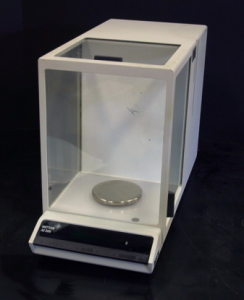Weighing a sample on a modern analytical balance is one of the most common measurements in a chemistry laboratory. Almost all of the analytical balances are electronic where the gravitational force of the sample is balanced by a magnetic force generated by an electromagnet. The current needed to maintain the position of the weighing pan is converted to a digital readout. This readout is calibrated against the current needed to balance an internal stainless steel weight. Modern balances can be accurate and reliable but are still susceptible to calibration and operation errors that affect the mass of the sample.
The Mettler AE200 balance that we use in the laboratory has a precision of 0.1 mg and a maximum capacity of 205 grams. Don’t tare or try to weigh things above 205 grams. The following points will help you obtain reliable weighing results.
Draft shields: The draft shields must be closed when weighing to avoid air turbulence and temperature changes.
Weighing pan: Place the sample in the middle of the weighing pan to avoid corner load errors.

Mettler AE200
Maintenance: Probably the most common weighing error is a dirty balance or unclean weighing vessel. Material, as small as a finger print, stuck to the weighing vessel or the balance pan will drastically affect the weight. The balance must be kept clean. If some material is spilled in the balance clean it immediately.
Use of the Mettler AE200:
- Have all glass doors closed.
- Press the single control bar to turn the instrument on.
- The instrument will zero itself after a few seconds.
- Add your weighing container (paper, boat). If you wish to tare (bring your scale back to zero after adding your weighing container), close glass doors, and press control bar briefly. There are times when you may not want to tare. Record weight. Add sample and record new weight. The difference between these weights will be the sample weight.
Physical Influences
Unstable or wrong weighing values are often caused by physical influences such as:
- Buoyancy
- Temperature
- moisture gain or loss by the weighing sample
- electrostatically charged weighing sample or vessel
- magnetic weighing samples or vessels
Temperature
A temperature difference between the weighing sample and its surroundings leads to air currents along the side of the weighing vessel that create dynamic buoyancy. The net result is that hot objects appear lighter and cold objects appear heavier. When possible, minimize the effects of temperature by letting the sample equilibrate to room temperature before weighing.
Electrostatics
A common sign of electrostatic effects is poor reproducibility. A weighing vessel that shows different weights may have become electrostatically charged. Materials that are good insulators like glass and plastic can become electrostatically charged when rubbed. Latex gloves also hold onto electrostatic charge that can be transferred to a weighing vessel. To avoid electrostatic effects do not rub weighing vessels with dry cloths/paper towels and, when possible, do not handle weighing vessels with latex gloves.
Here is a video about the proper use of a balance:
